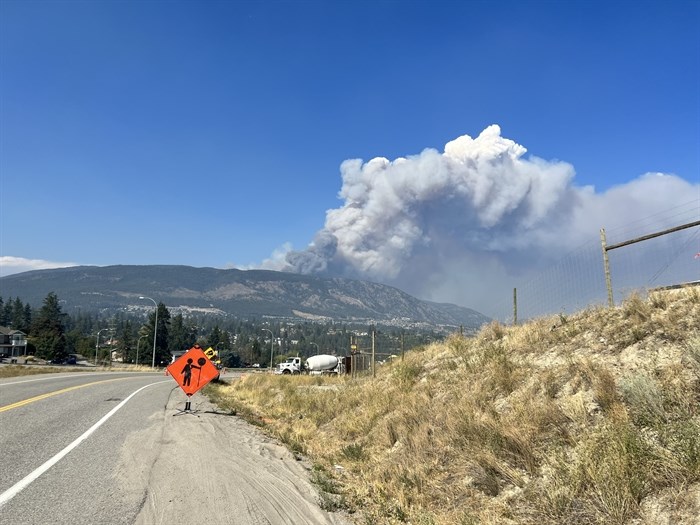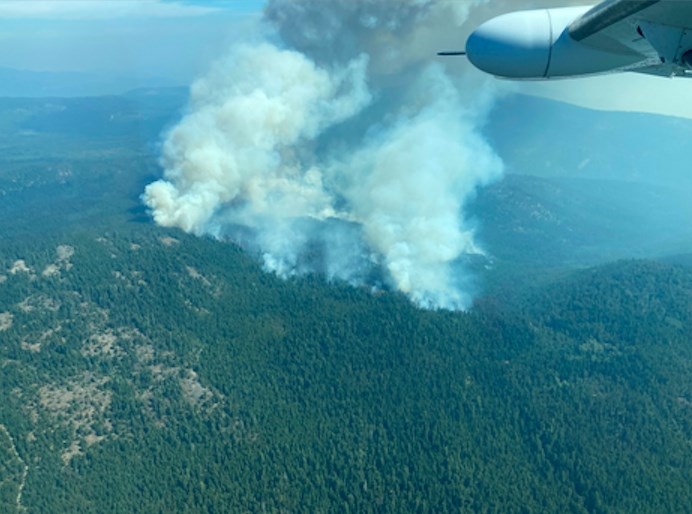
Police went door to door warning people to evacuate in the face of the McDougall Creek Wildfire on Aug. 17.
(MARSHALL JONES / iNFOnews.ca)
August 24, 2023 - 6:00 AM
It was clear last Thursday that much of the Southern Interior was ripe for an explosion in wildfire activity, which is just what happened.
Those living in the Thompson, Shuswap, North and South Okanagan could have gone to bed at night confident that, if the worst happened, their cell phones would blare into life with a warning to get out.
That’s because those regions, and many communities within them, subscribe to Voyent Alert! or Alertable, two privately operated versions of the newly created provincial emergency alarm system.
That’s not the case in the Central Okanagan where no jurisdiction offers that service.
“The difficulty with those systems is that they’re still subscription based so, as much as they seem like they’re a great idea overall, until you can get the one the province is working on, we’re left to our own subscription-based system,” Laura Wilson, a public information officer with the Central Okanagan Emergency Operations Centre, told iNFOnews.ca.
The Central Okanagan’s subscription based system allows it to send emails to people who subscribe.
READ MORE: Thousands on evacuation alert due to wildfire near West Kelowna
“In an emergency situation, as you escalate in priority, different kinds of communication come into play so we would send people down tactically on the ground if we need people out really, really quickly,” Wilson added. “That’s the best way to get them out of their house or out of an area.”
The difference with, for example, the Voyent Alert! System is that it can not only send out text messages prefaced with loud alarms but can also send voice messages, which is especially helpful for people who only have land lines.
It was launched in the Thompson-Nicola Regional District in the spring of 2020.
“Some of the motivation for what we see and what we do today is just having as many channels as possible – as the jurisdiction that would issue orders and alerts – to be able to provide that key emergency information directly to people,” Colton Davies, communications and marketing manager for the Thompson-Nicola Regional District, told iNFOnews.ca.
It now has 25,078 devices signed onto the system out of just over 17,000 residents in the unincorporated areas of the regional district.
Many of the municipalities in that regional district have their own versions of Voyent Alert!, including the City of Kamloops.
It has 26,904 subscribers.
“This has increased from 20,904 on June 30,” Kristen Rodrigue, acting communications manager for the City of Kamloops, said in an email to iNFOnews.ca. “This growth followed the start of the Rossmoore Lake Fire and, again, with the regional fire activity late last week.”
Kamloops has a population of about 98,000.
READ MORE: Wildfire evacuees could have had more notice if B.C. had Alberta's alert system
The alert apps are free to users and cost the local governments very little.
The regional district pays $3,000 a year and seven cents per subscriber for every alert or notification sent out.
Notices, for example, can be sent to subscribers who are serviced by one of that region’s 11 water systems. The largest one has 290 connections so, if they all subscribed (with only one device) it would cost $20 to send out a notice.
Kamloops pays an annual subscription fee of $14,800.
So, why is the Central Okanagan and/or its member municipalities not jumping on the bandwagon?
Board chair Loyal Wooldridge did not respond to requests for a comment by publication time.
Part of the reason could be that, last Thursday evening, an alarm did go out on the provincial emergency alert system at 10:10 p.m., likely at the request of local emergency officials.
It’s what’s called an “invasive” system, meaning it blares an alarm on all cell phones in a designated area.

The McDougal Creek Wildfire near West Kelowna has put almost 7,000 people on evacuation alert but they will only learn if they're ordered out if they check their email or get a knock on the door.
Image Credit: Submitted/BC Wildfire Service
That notice warned that, due to the McDougall Creek Wildfire, everyone needed to evacuate immediately if they lived in Rose Valley, West Kelowna Estates and all properties off Westside Road north of West Kelowna to Nahun.
“The wildfire poses a threat to human life,” the alert said, adding details on which people should head north to Vernon and which should head south to West Kelowna.
The problem was, iNFOnews.ca staff in Kelowna and Vernon got the message but not the one living in West Kelowna. One evacuated resident said her husband got the alert on his phone but she did not, possibly because she has a pre-paid phone.
“Emergency alerting to cellphones is geo-targeted and can target a limited area of coverage,” says an email to iNFOnews.ca from Ministry of Emergency Management and Climate Readiness. “The reach of cell towers in the warning area may extend outside the intended boundaries of the emergency alert. This means that some people may receive alert messages outside the warning area.”
The Ministry, in a separate email, said the message was sent by the City of West Kelowna and the regional district. Cell phones have to be alert compatible and connected to a 4G or 5G network to receive alerts.
Such alerts are issued at the request of local authorities. To date, 19 alerts have been broadcast for wildfires and there have been two Amber Alerts requested by the RCMP.
On the day the McDougall Creek fire took off, the Central Okanagan Emergency Services Centre sent out its first evacuation order for 68 properties at 1:25 p.m.
That was expanded less than two hours later to include another 924 properties then expanded twice more before the provincial alert went out at 10:10 p.m.
That means it took boots on the ground to get the message out.
“Last night, police officers just kept coming and I don’t know where they came from but they knocked on every single door that I asked them to,” West Kelowna Fire Rescue Chief Jason Brolund told a news briefing the next day. “It was thousands of doors that were knocked on.”
Is that how you found out you were evacuated?
Would it have made a difference to your evacuation efforts if you had received an alert on your phone at the same time the emails went out?
Let us know in the comments section below.
To contact a reporter for this story, email Rob Munro or call 250-808-0143 or email the editor. You can also submit photos, videos or news tips to the newsroom and be entered to win a monthly prize draw.
We welcome your comments and opinions on our stories but play nice. We won't censor or delete comments unless they contain off-topic statements or links, unnecessary vulgarity, false facts, spam or obviously fake profiles. If you have any concerns about what you see in comments, email the editor in the link above. SUBSCRIBE to our awesome newsletter here.
News from © iNFOnews, 2023